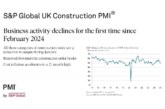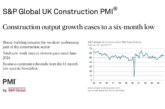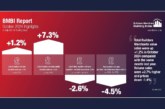
The Construction Products Association’s latest Construction Trade Survey shows that firms across the construction industry reported growth in activity in the second quarter of 2015, marking the ninth consecutive quarter of growth. However, the near-term outlook is clouded by labour supply issues and rising wage costs.
Key survey findings include:
- 17% of building contractors, on balance, reported that construction output rose in the second quarter of 2015 compared with a year ago
- Private housing output rose in Q2 according to 43% of building contractors, on balance
- 18% of building contractors, on balance, reported that private commercial output rose in the second quarter of 2015 compared with a year ago
- 9% of building contractors reported a fall in non-housing repair and maintenance output in Q2, on balance
- 9% of contractors, on balance, reported a fall in orders for housing R&M and 14% for non-housing R&M in Q2
- Public housing orders decreased in Q2 according to 44% of building contractors, on balance
- On balance, 43% of specialist contractors and 28% of SMEs reported an increase in enquiries in Q2
- 50% of building contractors reported difficulties recruiting carpenters, 49% for bricklayers and 45% for plasterers in Q2
- 57% of firms reported labour costs rose in Q2 compared with the previous quarter
Commenting on the survey, Dr Noble Francis, Economics Director at the Construction Products Association, said: “Firms across the whole construction supply chain, including building contractors, SMEs, specialist contractors, civil engineers and product manufacturers all reported rises in output during Q2.
“Continuing the trend since recovery emerged in mid-2013, growth in output was led by the private housing sector, in which 43% of firms, on balance, reported a rise in output. Increased output was also reported in private commercial, the largest construction sector, where 18% of firms, on balance, reported rising volumes of offices and retail work. Contractors reported a decline in repair and maintenance work in Q2, reflecting a drop-off in measures installed under government schemes to boost energy efficient in recent months.
“The £23billion R&M sector will undoubtedly be affected by this and the government’s decision to close the Green Deal last month. Contractors reported a broad fall in orders across all sectors in Q2, however, not just for R&M. This will be countered to some extent by the fact that civil engineers, specialist contractors and SMEs reported an increase in new enquiries or orders in the quarter, whilst product manufacturers were upbeat over the outlook for sales.
“Of lingering concern,” Dr Francis concluded, “nine quarters of rising construction activity and expectations of higher workloads over the coming year raise the issue of whether the supply of skilled labour will meet demand. Half of contractors have already reported difficulties recruiting on-site trades such as carpenters, bricklayers and plasterers.”
Suzannah Nichol, Chief Executive of Build UK (merger of UKCG & NSCC), said: “The outlook remains positive with building contractors enjoying rising output and almost half of Specialist Contractors looking at expansion in the next quarter. However, the impact of skills shortages continues to be felt, not least through increased labour costs. To overcome the difficulties the industry is facing in recruiting key trades, we need to focus on improving the image of construction and tackling apprenticeship reform.”
Richard Beresford, Chief Executive of the National Federation of Builders, added: “Despite nine consecutive quarters of reported growth, and healthy order books, future growth is far from assured. The severity of the skills shortage is such that the industry will see unsustainable rising labour costs or an increasing inability to deliver work. Industry’s efforts to address skills shortages cannot take effect soon enough.”









